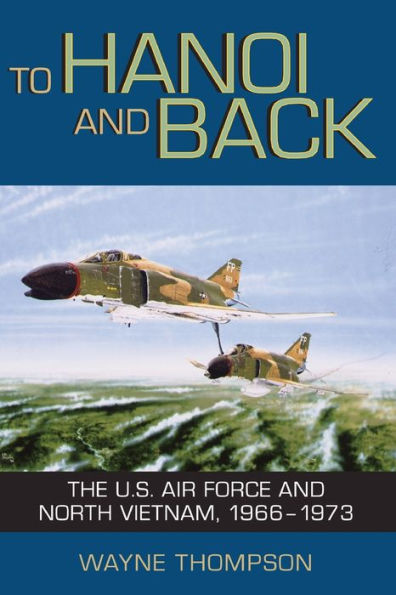To Hanoi and Back: The U.S. Air Force and North Vietnam, 1966-1973
After nearly eighteen months of the largely unsuccessful bombing campaign called Operation Rolling Thunder, the US Air Force began to look for ways to overcome technological, geographical, and political challenges in North Vietnam and use limited air power more effectively. In 1972 the two Linebacker campaigns joined with other air operations to make a dramatic, although temporary, difference. While they unleashed powerful B-52 area bombers, the campaigns also demonstrated the efficacy of newly developed laser-guided precision bombs.
Drawing upon twenty years of research in classified records, Wayne Thompson integrates operational, political, and personal detail to present a full history of the Air Force role in the war against North Vietnam. He provides an unprecedented view of the motivations and actions of the people involved—from aircrews to generals to politicians—in every phase of the air campaigns. He outlines, for instance, the political reasons for President Johnson's reluctance to use B-52 bombers against major North Vietnamese targets. He also examines how the media influenced US policy and how US prisoners became the war's most celebrated heroes.
The war in Southeast Asia ultimately pushed the Air Force toward adopting more flexible tactics and incorporating increasingly sophisticated weapons that would shape later conflicts.
1117918313
Drawing upon twenty years of research in classified records, Wayne Thompson integrates operational, political, and personal detail to present a full history of the Air Force role in the war against North Vietnam. He provides an unprecedented view of the motivations and actions of the people involved—from aircrews to generals to politicians—in every phase of the air campaigns. He outlines, for instance, the political reasons for President Johnson's reluctance to use B-52 bombers against major North Vietnamese targets. He also examines how the media influenced US policy and how US prisoners became the war's most celebrated heroes.
The war in Southeast Asia ultimately pushed the Air Force toward adopting more flexible tactics and incorporating increasingly sophisticated weapons that would shape later conflicts.
To Hanoi and Back: The U.S. Air Force and North Vietnam, 1966-1973
After nearly eighteen months of the largely unsuccessful bombing campaign called Operation Rolling Thunder, the US Air Force began to look for ways to overcome technological, geographical, and political challenges in North Vietnam and use limited air power more effectively. In 1972 the two Linebacker campaigns joined with other air operations to make a dramatic, although temporary, difference. While they unleashed powerful B-52 area bombers, the campaigns also demonstrated the efficacy of newly developed laser-guided precision bombs.
Drawing upon twenty years of research in classified records, Wayne Thompson integrates operational, political, and personal detail to present a full history of the Air Force role in the war against North Vietnam. He provides an unprecedented view of the motivations and actions of the people involved—from aircrews to generals to politicians—in every phase of the air campaigns. He outlines, for instance, the political reasons for President Johnson's reluctance to use B-52 bombers against major North Vietnamese targets. He also examines how the media influenced US policy and how US prisoners became the war's most celebrated heroes.
The war in Southeast Asia ultimately pushed the Air Force toward adopting more flexible tactics and incorporating increasingly sophisticated weapons that would shape later conflicts.
Drawing upon twenty years of research in classified records, Wayne Thompson integrates operational, political, and personal detail to present a full history of the Air Force role in the war against North Vietnam. He provides an unprecedented view of the motivations and actions of the people involved—from aircrews to generals to politicians—in every phase of the air campaigns. He outlines, for instance, the political reasons for President Johnson's reluctance to use B-52 bombers against major North Vietnamese targets. He also examines how the media influenced US policy and how US prisoners became the war's most celebrated heroes.
The war in Southeast Asia ultimately pushed the Air Force toward adopting more flexible tactics and incorporating increasingly sophisticated weapons that would shape later conflicts.
29.95
In Stock
5
1

To Hanoi and Back: The U.S. Air Force and North Vietnam, 1966-1973
432
To Hanoi and Back: The U.S. Air Force and North Vietnam, 1966-1973
432
29.95
In Stock

Product Details
| ISBN-13: | 9781588342836 |
|---|---|
| Publisher: | Smithsonian Institution Press |
| Publication date: | 07/06/2010 |
| Pages: | 432 |
| Product dimensions: | 8.90(w) x 5.90(h) x 0.90(d) |
About the Author
From the B&N Reads Blog
